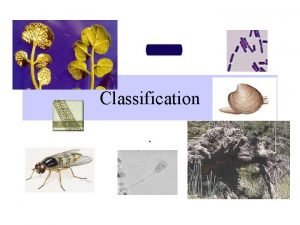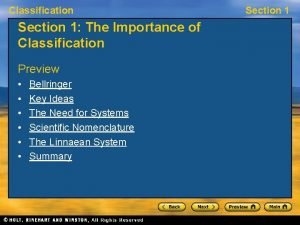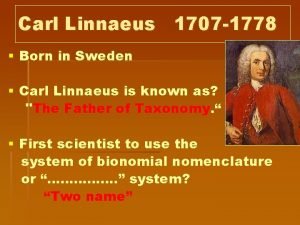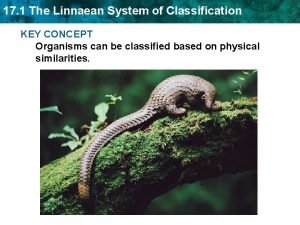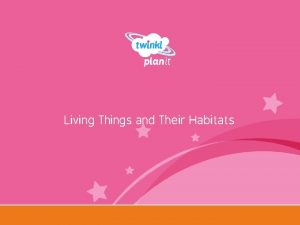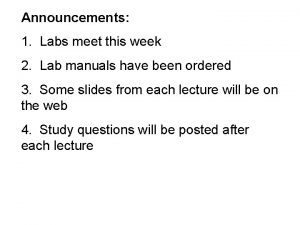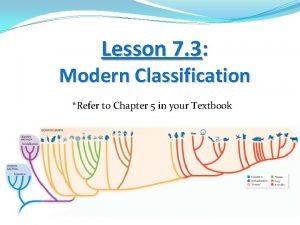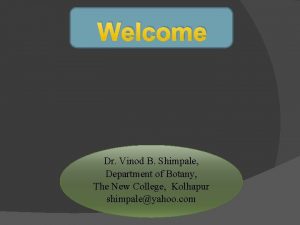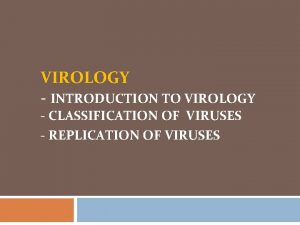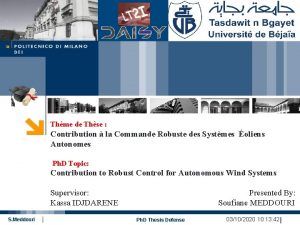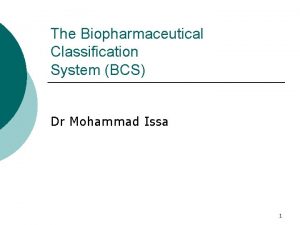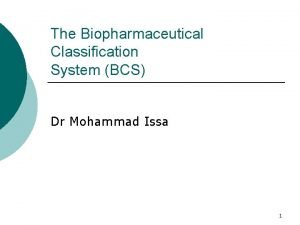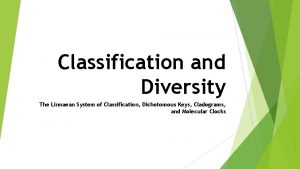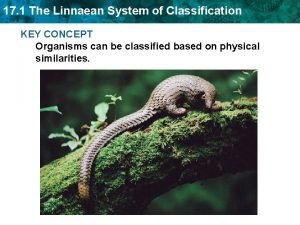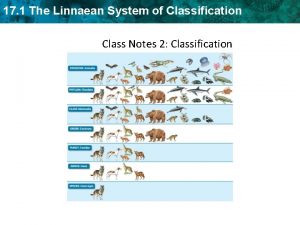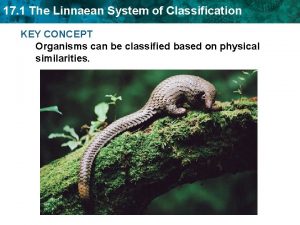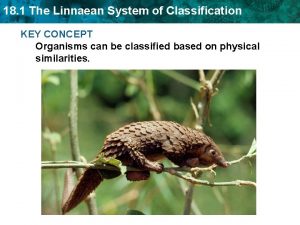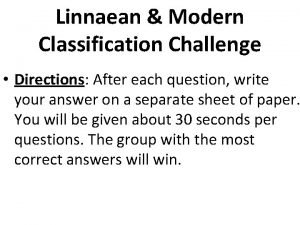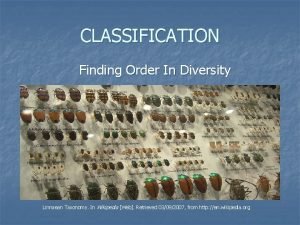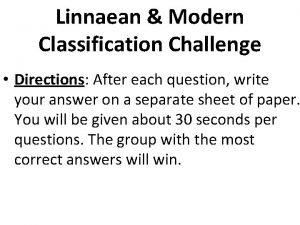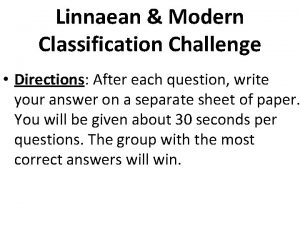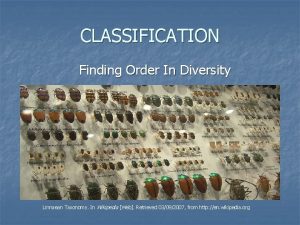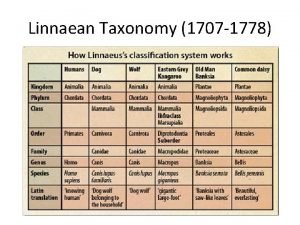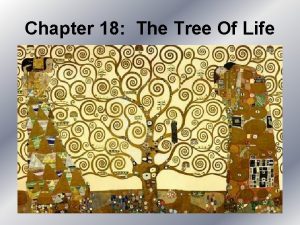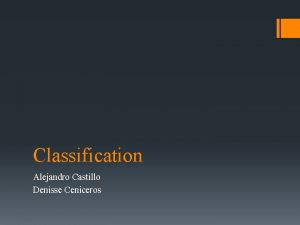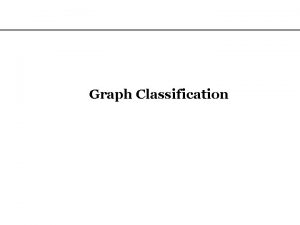Classification 17 1 The Linnaean System of Classification





























































- Slides: 61

Classification.

17. 1 The Linnaean System of Classification • Georgia Standard • SB 3. b Compare how structures and function vary between the six kingdoms (archaebacterial, eubacteria, protists, fungi, plants, and animals. )

Taxonomy • • The science of naming organisms Uses Latin Language = dead language (no slang) Carolus Linnaeus: 1750’s Binomial nomenclature= two name naming system – First word = Genus. Grouped on major characteristics. All organisms with the same characteristics are in the same genus – Second word = species. Describes the organism. – Quercus ruba or Quercus ruba • Problem: Used the organisms Morphology to classify it. Now phylogeny is included. • Devised the binomial nomenclature

Linnaean System of Classification King Please Close Our Front Gate Soon • • Kingdom Phylum Class Order Family Genus Species- smallest grouping; one species

Your Full Human Name • • Domain = Eukarya Kingdom = Animalia Phylum = Chordata Class = Mammalia Order = Primates Family = Hominidae Genus = Homo Species = sapien

Modern Classification system: Three Domain Classification System • Archaebacteria- oldest kingdom 4 bill. yrs

Dichotomous Key Lab Pg. 522 • Use the dichotomous key on pg. 522 to identify these beans. • After you have ID the • Beans do the lab!

Phylogenic Taxonomy • Systemic taxonomy: reflects an organisms phylogeny. – Phylogenetic tree: family tree that shows evolutionary relationships. • Subject to change as new evidence comes to light. Uses DNA, and protein sequences. Tutorial For You At Home

Phylogenic Tree

17. 2 Classification Based on Evolutionary Relationships Georgia Standard SB 3. c Examine the evolutionary basis of modern classification systems (archaebacterial, eubacteria, protists, fungi, plants, and animals. )

What is Cladistics? • Cladistics: Classification based on common ancestry, or phylogeny. • Clade: shares a common ancestor. • Derived Characteristics: trait shared by some species but are not present in others, ie: Feathers, hair, roots. • Node: Place where a branch splits.


Notice: Evolutionary characteristics but not necessarily relationships.


Now you try it! Pg. 525 • Quick Lab: Construct a cladogram • First: Copy the cladogram into your notebook. • Second: Fill out the cladogram • Third: Do the Analyze and Conclude questions with full sentences.

17. 3 Molecular Clocks • Georgia Standard • SB 3. b Compare how structures and function vary between the six kingdoms (archaebacterial, eubacteria, protists, fungi, plants, and animals. ) • SB 3. c Examine the evolutionary basis of modern classification systems (archaebacterial, eubacteria, protists, fungi, plants, and animals. )

What are Molecular Clocks used for? • Use mutation rates to measure evolutionary time. (compare fossils to modern organisms) • Fig. 17. 8 • Two types of clocks: – Mitochondrial DNA: Fig 17. 10 inherited only from the mothers mitochondria. – Ribosomal RNA: (r. RNA) low mutation rate.

17. 4 Domains and Kingdoms • Georgia Standard • SB 3. b Compare how structures and function vary between the six kingdoms (archaebacterial, eubacteria, protists, fungi, plants, and animals. ) • SB 3. c Examine the evolutionary basis of modern classification systems (archaebacterial, eubacteria, protists, fungi, plants, and animals. )

Classification is always a work in progress? • Why? • Fig. 17. 11

What are three domains of life? • Bacteria: Single celled prokaryotes with circular DNA. • Archea: single-celled prokaryotes with circular DNA. Extremophiles. • Eukarya: nucleus with membrane bound organelles. Stick-like DNA. Kingdoms: Protista, Plantae, Fungi, and Animalia.


Domain Bacteria: live in moderate environments. (On your teeth and contact lenses. )

Characteristics of Bacteria • • Unicellular Prokaryotes No introns Thick, rigid, Peptidoglycan cell walls • Anaerobes or Aerobes • Some are Decomposers or Pathogens • Some use conjugation • E. Coli • Some used to fix nitrogen for the nitrogen cycle • Viruses placed here for lack of a place to put them.

• Domain Bacteria and Kingdom Eubacteria …Peptidoglycan in cell wall …DNA unlike eukaryotes

Bacteria Anatomy Cell Wall Capsule Endospore Pili Flagella

• Bacteria commonly come in three forms. – rod-shaped, called bacilli – spiral, called spirilla or spirochetes – spherical, called cocci Lactobacilli: rod-shaped Enterococci: spherical Spirochaeta: spiral

Bacteria can evolve resistance to antibiotics. A bacterium carries genes for antibiotic resistance on a plasmid. A copy of the plasmid is transferred through conjugation. Resistance is quickly spread through many bacteria.

Viruses • Nonliving particle that can cause disease. • Composed of a protein coat and nucleic acid




Viruses cause two types of infections. • Lytic host bacterium The bacterophage attaches and injects it DNA into a host bacterium. The host bacterium breaks apart, or lyses. Bacteriophages are able to infect new host cells. The viral DNA forms a circle. The viral DNA directs the host cell to produce new viral parts. The parts assemble into new bacteriophages. The virus may enter the lysogenic cycle, in which the host cell is not destroyed.

• Lysogenic The prophage may leave the host’s DNA and enter the lytic cycle. The viral DNA is called a prophage when it combines with the host cell’s DNA. Many cell divisions produce a colony of bacteria infected with prophage. Although the prophage is not active, it replicates along with the host cell’s DNA.

Domain Archaea: the Extremophiles

Characteristics of Archaea • • • Extremophiles Unicellular – thermophiles, which live at Prokaryotes high temperatures; – hyperthermophiles, which Some introns live at really high temperatures (present record is 121°C!); No peptidoglycan in – psychrophiles, which like it cell cold (one in the Antarctic grows best at 4°C); • Ribosomal RNA more – halophiles, which live in very closely related to saline environments (like the Eukaryotes than Dead Sea); – acidophiles, which live at low bacteria p. H (as low as p. H 1 and who die at p. H 7!); – alkaliphiles, which thrive at a high p. H.


Domain Eukarya: the 4 Kingdoms!! • Protista- 1. 5 billion years ago. Most diverse kingdom plant-like, animal-like, and fungi-like • Animals- heterotrophs, mobile, no cell wall 700 M • Plants- autotrophs, immobile, cell wall 400 Mill • Fungi-heterotrophs, cell wall, immobile 400 Mill.

Characteristics of Domain Eukarya • Nucleus and Organelles • No peptidoglycan in cell walls • Introns • 4 kingdoms

Kingdom Protista • Widest variety of organisms • They are in this kingdom because of what they are not. Not animals, Fungi, or Plants • Single and multicelled • Heterotrophs and Autotrophs • Some use conjugation (yes, like bacteria)

Protists: Plant-like varieties • Single or Multicellular, Photosynthetic = Algae: Green, Brown, and Red • No Roots, Stems, or Leaves! • Types: – Dinoflagellates- cause red tides – Diatoms- reflective paint, toothpaste – Kelp

Kelp

Animal-like Protists • Unicellular, heterotrophs some can photosynthesize =Protozoans (Zoa: zoo) • Grouped by how they move… – Flagellates – Psuedopodia – Cilliates • Infamous Protozoans – African sleeping sickness and Giardias – Sporozoans= malaria – Flagellate= termites digestive friend, have flagella – Amoebas= dysentery, move by pseudopodia

Malaria: The life Cycle

Amoebas

Protista: Animal-like/ Plant like Euglenids • All are Unicellular (animals are all multicellular) • Many Euglenoids feed by phagocytosis. 1/3 d of the species of Euglenids are photosynthetic but can become heterotrophic when sunlight is unavailable. • Euglena use flagella for moving. The outer covering called a pellicle, is flexible and assists in moving. • Some have an eyespot with a photoreceptor is capable of detecting the presence of light. • Reproduction is asexual. • .

Fungi-like Protists • Decomposes organic materials • Can move at some point in their life. • Types – Slime molds – Water molds (includes mildew) Irish Potato Famine 1845 -49

Kingdom Fungi • • Heterotrophic Cell walls made of chitin No roots, leaves, stems Hyphae and mycelium. Most of the Fungi cannot be seen. • Extracellular digestion through hydrolytic enzymes • Decomposers • Some have Fruiting body: Mushroom

Edible and Non edible Forms • • Yeast makes beer and bread Blue cheese- penicillin Morels and others Citric Acid

Fungi can Infect you • Oral Thrush and Athletes Foot

Fungi are grouped by… • Reproductive structures. • Primitive Fungi (Phylum Chytridiomycota) – Primitive water fungi with flagella on their spores • Sac fungi (Phylum Ascomycota) – Yeast, Morels, Truffles, Penicillium • Club Fungi (Phylum Basidiomycota) • Bread Molds (Phylum Zygomycota) – Mycorrhizae: nitrogen fixers

Mutualistic Fungi • Mycorrhizae: nitrogen fixers. Mutualistic relationship between a fungi and plant roots. • Lichen: relationship between a fungi and algae or photosynthetic bacteria. • Fungal gardens and insects. Mutualistic relationship between a fungi and animal. Leaf cutter ants feed fungi leaves, ants eat the fungi.

Kingdom Plantae • Photosynthetic autotrophs with a cell wall • Bryophytes: no vascular tissue – Nonvasuclar land plants: Moss Liverwarts

More Plants • Plants with stems: Whisk fern • Plants with leaves and stems: Equesetum • Ferns

More Plants • Gymnosperms • Cycads and Ginkgo • Junipers , Cypress , and Pine

Modern Plants • Angiosperms- flowering plants • Deciduous Trees

Patterns of Embryological Development • Zygote: fertilized egg • Blastula: hollow ball of cells • Gastrula: caved in ball of cells , the opening becomes the mouth or anus of an organism. – Insects: Mouth- Protosome – Echinoderms: Anus-Deuterosome – Which one are you?


Kingdom Animalia • Most ancient animals = sponge • Cnidarians or jellyfish, coral, sea anemones

What came next in the Animal Kingdom? • Flatworms and round worms • Mollusks Snails and Octopus • Annelids earthworms and leeches

More Animals • Arthropods- Jointed appendages • Chordates- internal skeleton

There are so many living things how can we find them quickly? • Dichotomous Key. By comparing two opposing traits at one time a quick identification can be made. • Lab time
 Linnaean taxonomy
Linnaean taxonomy Linnaean classification
Linnaean classification Kev bellringer
Kev bellringer Linnaeus classification system
Linnaeus classification system Linnaean taxonomic system
Linnaean taxonomic system Cow taxonomy
Cow taxonomy Jackal linnaean system
Jackal linnaean system What is taxon
What is taxon Linnaean taxonomy
Linnaean taxonomy Hình ảnh bộ gõ cơ thể búng tay
Hình ảnh bộ gõ cơ thể búng tay Ng-html
Ng-html Bổ thể
Bổ thể Tỉ lệ cơ thể trẻ em
Tỉ lệ cơ thể trẻ em Chó sói
Chó sói Chụp phim tư thế worms-breton
Chụp phim tư thế worms-breton Hát lên người ơi
Hát lên người ơi Các môn thể thao bắt đầu bằng tiếng chạy
Các môn thể thao bắt đầu bằng tiếng chạy Thế nào là hệ số cao nhất
Thế nào là hệ số cao nhất Các châu lục và đại dương trên thế giới
Các châu lục và đại dương trên thế giới Công thức tiính động năng
Công thức tiính động năng Trời xanh đây là của chúng ta thể thơ
Trời xanh đây là của chúng ta thể thơ Mật thư anh em như thể tay chân
Mật thư anh em như thể tay chân Phép trừ bù
Phép trừ bù độ dài liên kết
độ dài liên kết Các châu lục và đại dương trên thế giới
Các châu lục và đại dương trên thế giới Thể thơ truyền thống
Thể thơ truyền thống Quá trình desamine hóa có thể tạo ra
Quá trình desamine hóa có thể tạo ra Một số thể thơ truyền thống
Một số thể thơ truyền thống Cái miệng bé xinh thế chỉ nói điều hay thôi
Cái miệng bé xinh thế chỉ nói điều hay thôi Vẽ hình chiếu vuông góc của vật thể sau
Vẽ hình chiếu vuông góc của vật thể sau Nguyên nhân của sự mỏi cơ sinh 8
Nguyên nhân của sự mỏi cơ sinh 8 đặc điểm cơ thể của người tối cổ
đặc điểm cơ thể của người tối cổ Ví dụ giọng cùng tên
Ví dụ giọng cùng tên Vẽ hình chiếu đứng bằng cạnh của vật thể
Vẽ hình chiếu đứng bằng cạnh của vật thể Tia chieu sa te
Tia chieu sa te Thẻ vin
Thẻ vin đại từ thay thế
đại từ thay thế điện thế nghỉ
điện thế nghỉ Tư thế ngồi viết
Tư thế ngồi viết Diễn thế sinh thái là
Diễn thế sinh thái là Các loại đột biến cấu trúc nhiễm sắc thể
Các loại đột biến cấu trúc nhiễm sắc thể Số.nguyên tố
Số.nguyên tố Tư thế ngồi viết
Tư thế ngồi viết Lời thề hippocrates
Lời thề hippocrates Thiếu nhi thế giới liên hoan
Thiếu nhi thế giới liên hoan ưu thế lai là gì
ưu thế lai là gì Khi nào hổ mẹ dạy hổ con săn mồi
Khi nào hổ mẹ dạy hổ con săn mồi Sự nuôi và dạy con của hổ
Sự nuôi và dạy con của hổ Hệ hô hấp
Hệ hô hấp Từ ngữ thể hiện lòng nhân hậu
Từ ngữ thể hiện lòng nhân hậu Thế nào là mạng điện lắp đặt kiểu nổi
Thế nào là mạng điện lắp đặt kiểu nổi Closed open and isolated systems
Closed open and isolated systems Respiratory system circulatory system digestive system
Respiratory system circulatory system digestive system Eager learner vs lazy learner
Eager learner vs lazy learner Manifold table in statistics
Manifold table in statistics Traditional classification vs modern classification
Traditional classification vs modern classification Apg system of classification
Apg system of classification Baltimore classification
Baltimore classification Neurological exam
Neurological exam Control techniques
Control techniques Biopharmaceutics classification system
Biopharmaceutics classification system Bcs classification of drug
Bcs classification of drug

